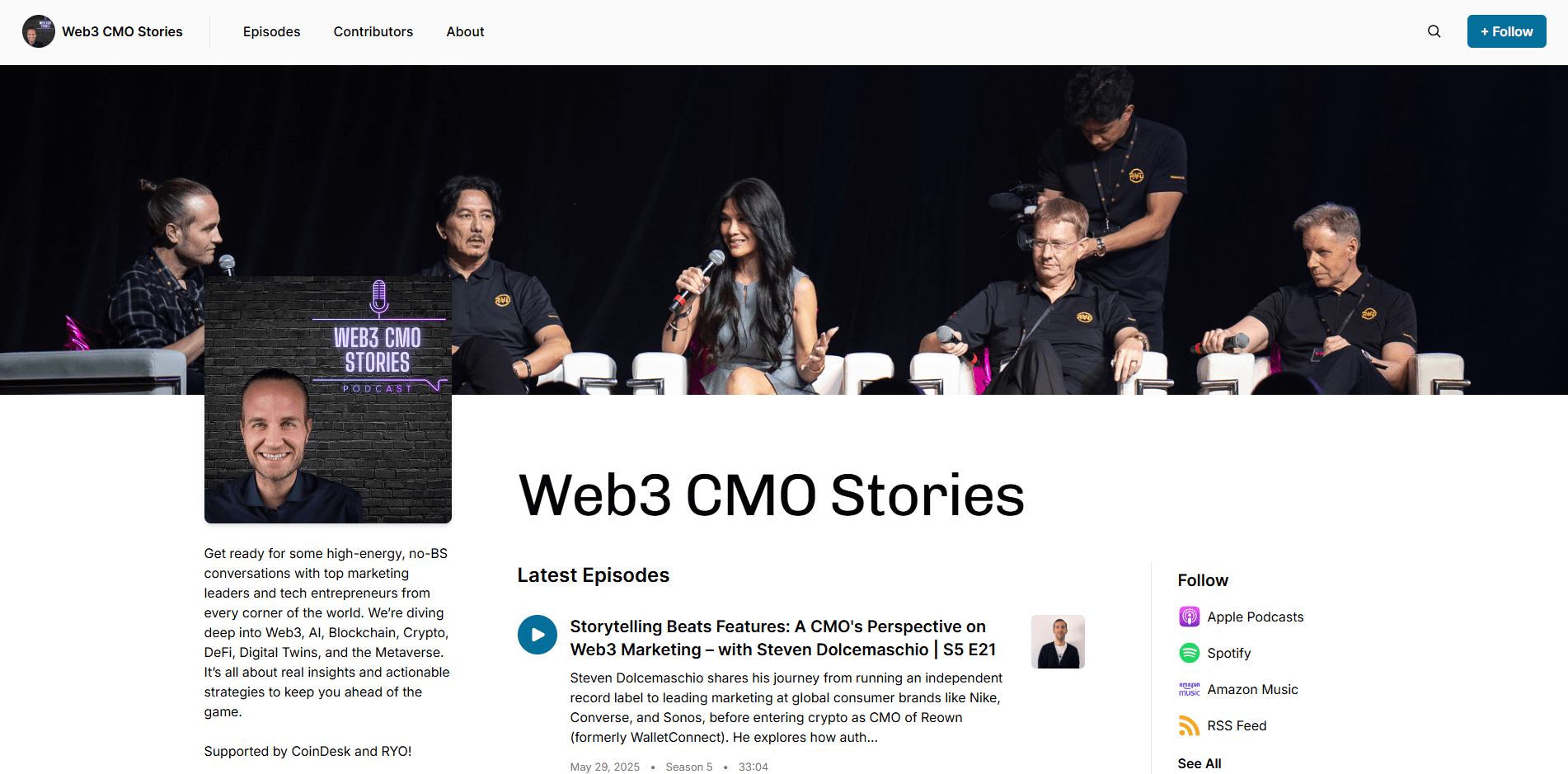
Today, we're joined by Joeri Billast, the host of Web3 CMO Stories, a leading podcast where he interviews marketing leaders, founders, and storytellers shaping the future of Web3. The show ranks among the top 5% of podcasts globally and was supported by CoinDesk last year. Joeri was also recently featured on Cryptopolitan, further cementing his role as a voice in the Web3 space.
Beyond the podcast, Joeri curates Sintra Synergies, an exclusive leadership retreat in Portugal for AI and Web3 innovators. It’s not just about panels and pitch decks — it’s about diving deep into what truly drives sustainable adoption, long-term visibility, and meaningful collaboration.
Let’s dive into Joeri’s journey, his vision for the future of Web3, and the impact he’s making through storytelling and community-building.
Chris: Web3 CMO Stories ranks in the top 5% globally — an impressive feat. What was your original vision when launching the podcast, and how did you carve out a niche in such a noisy space?
Joeri: When I launched Web3 CMO Stories, my goal was to create a space where marketers and founders could talk about the human side of Web3 and AI, not just the tech. I saw too many founders shouting for attention but building no trust. So I flipped the script: real conversations with those who’ve earned influence, not rented it.
The niche came naturally: marketing leaders in Web3 rarely had a dedicated platform. We’re now one of the few shows focused specifically on Web3 go-to-market, storytelling, and adoption, not speculation.
Chris: What gap in the Web3 ecosystem did you feel needed a platform like Web3 CMO Stories — especially when it comes to giving marketers and storytellers a voice?
Joeri: There’s a massive credibility gap in Web3. People trust stories, not roadmaps. Yet marketers in this space are often treated as an afterthought.
I built Web3 CMO Stories to shift that. It’s a platform for those turning complexity into clarity, hype into habit, and users into communities. We don’t just talk tech, we talk narrative, positioning, trust, and community building. These voices deserve the spotlight if we’re serious about onboarding the next 100 million users.
Chris: With so many projects struggling to stand out, how do you select guests who provide real value versus just promoting their tokens?
Joeri: I ask one question before confirming any guest: Would this person provide insight even if they weren’t launching anything?
My guests are usually founders, CMOs or strategists who have built more than just a whitepaper. We look for real traction, a unique POV, and the willingness to speak honestly, even about failures. Many come from personal referrals, trusted partners, or previous live interactions.
If it’s pure promotion, it’s a no. We’re here to inspire action, not inflate tokens.
Chris: You touch on DeFi, AI, Digital Twins, and the Metaverse — how do you balance breadth with depth so listeners walk away with insights rather than buzzwords?
Joeri: Great question: the key is curated context. I see these topics not as silos, but as signals of where user behavior is heading.
So we zoom in on how these trends affect actual storytelling, adoption, and strategy. If we talk AI, it’s “How do you use GPT to build better community comms?” If we cover the Metaverse, we ask, “What does attention look like in an immersive world?”
I always bring it back to real users, real tools, real traction. That’s what keeps listeners tuned in.
Chris: Being supported by CoinDesk and featured on Cryptopolitan is a big deal. How did these relationships come about, and how have they impacted your reach or credibility?
Joeri: CoinDesk supported my show during their Consensus 2024 campaign, where I helped create more awareness and drive ticket sales for their flagship event in Austin. That collaboration gave Web3 CMO Stories a strong credibility boost and opened doors to new guests, partners, and sponsors.
Interestingly, they contacted me through the contact form on my personal website / blog — which is connected to the podcast site. It shows how important it is to stay consistent with content and visibility across channels.
Cryptopolitan, on the other hand, featured the podcast independently. They recognized our unique editorial angle — focusing on marketing and storytelling rather than token speculation.
These media mentions are valuable signals. But what truly drives growth is showing up consistently with conversations that deliver insight and spark trust. That’s the foundation of Web3 CMO Stories.
Chris: What’s one common misconception about Web3 marketing that keeps coming up in your conversations — and how do your guests typically debunk it?
Joeri: The biggest myth? That Web3 marketing is just Web2 + Discord + memes.
The reality: Web3 marketing is community-first, incentive-aligned, and trust-driven. My guests constantly highlight how marketing here must be integrated with tokenomics, governance, and even product design. It’s not just about reaching users — it’s about co-building with them.
This is not a layer added after dev. It’s part of the DNA.
Chris: Why do you prefer to focus on audio for your podcast and are not yet scaling on YouTube?
Joeri: That’s a great question — and a strategic decision.
Before launching Web3 CMO Stories, I experimented with YouTube content under sub-brands like #AskJoeri and EFFICADOTV, which were more focused on general digital marketing. But when I started the podcast in January 2022, I realized that audio was the perfect format for the types of deep, strategic conversations I wanted to have.
Most of my guests are busy Web3 founders, marketers, or event speakers – often available for quick audio chats, even on the go. Recording audio is more flexible, faster to produce, and fits naturally into both their lives and mine. It also allows me to publish more consistently — I’ve now released about 250 episodes, which wouldn’t have been possible with a video-first workflow.
While I do occasionally publish episodes on YouTube and may scale that channel later, my traction so far has come primarily through audio platforms like Spotify, Apple Podcasts, and Google Podcasts. Audio has brought me not only loyal listeners, but also sponsors, it scales with less friction and more impact.
Thanks to AI tools like Descript (which I also advise clients on), I can now produce, edit, and publish episodes efficiently, often within a 1 or 2 hours. That’s the beauty of being audio-first in an AI-powered era.
Chris: Tell us about Sintra Synergies — a retreat concept that sounds radically different from typical Web3 events. What inspired it, and how does it complement the podcast?
Joeri: Sintra Synergies is my answer to shallow conferences and over-networked events.
It’s a curated off-grid Web3 leadership experience in Portugal for Web3 and AI builders who care about long-term impact. No stages. No pitches. Just real conversations, guided strategy sessions, and nature-fueled connection.
It complements the podcast perfectly: Web3 CMO Stories is where you hear the ideas. Sintra is where you act on them — alongside the people you want to build with.
I’m now forming the pilot group of 15-20 founding members. Check out the Sintra Synergies website for more info..
Chris: What have been the biggest marketing mistakes you’ve seen Web3 founders or CMOs repeat across your interviews?
Joeri: Three come up again and again:
- Launching before listening – They skip real user discovery.
- Confusing attention with adoption – Going viral ≠ growing.
- Treating marketing as a post-dev activity – It's not. It's core.
The best founders build with a narrative, not after it. They align brand, product, and community from day one.
Chris: When you look 3–5 years ahead, what role do you see podcasting and personal storytelling playing in how we onboard the next 100 million users into Web3?
Joeri: A massive one. Because onboarding is not about teaching tech — it’s about building trust.
Podcasting allows for long-form, human-centered storytelling. People buy into people before they buy into platforms. If we want to bring the next 100M users into Web3, we need more conversations, not conversions.
I believe podcasters, creators, and community leaders will become the new onboarding layer, because we speak human, not protocol.





 usdt
usdt xrp
xrp

